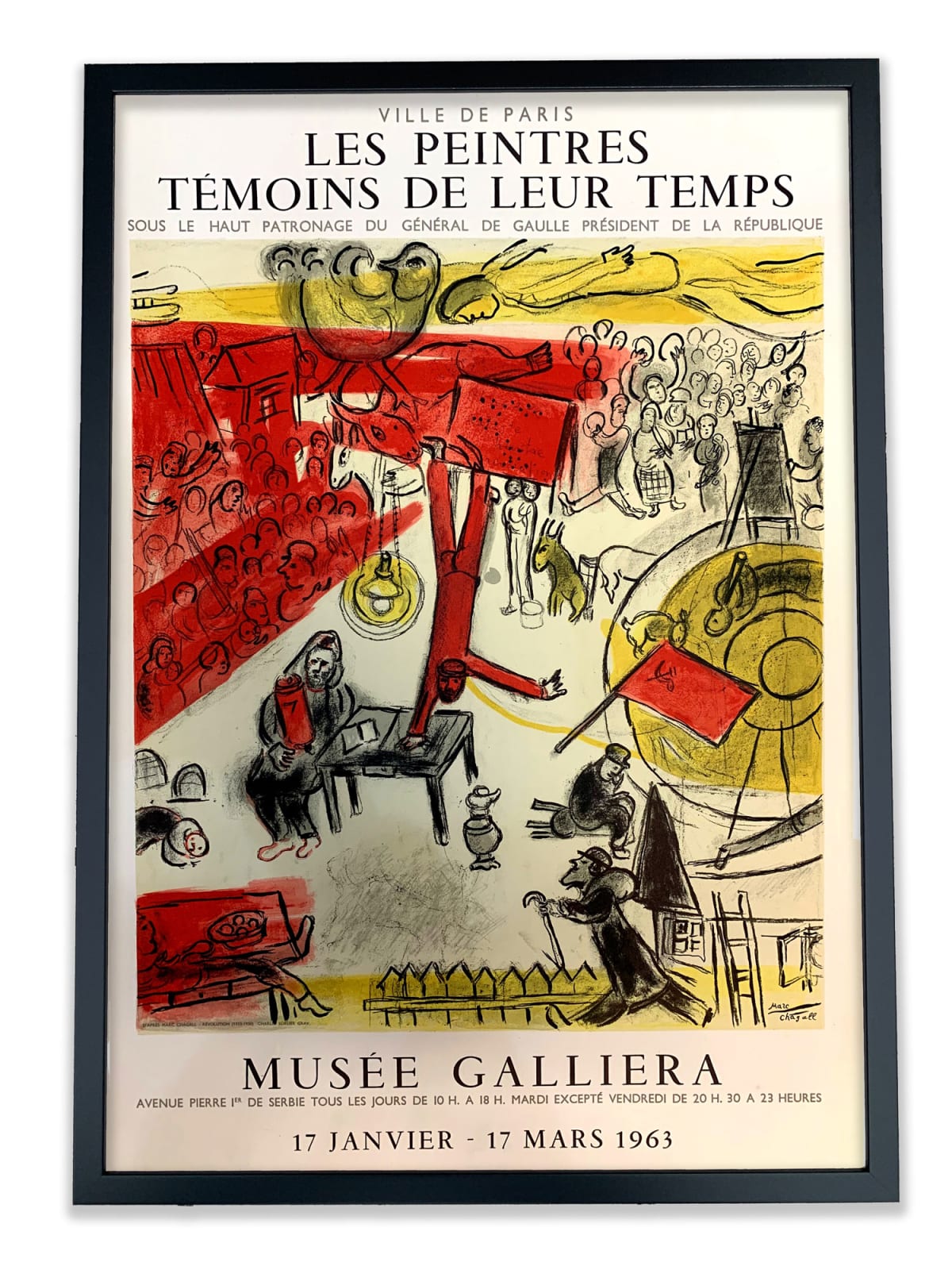Marc Chagall
Les Peintres temoins de leurs Temps — La Révolution, 1963
Colour lithograph Printed By Mourlot
75cm x 51cm (framed)
Our “Modern Prints”, in the majority of cases, are posters designed by artists with the intention to advertise their exhibitions. These posters are based on an original draft by the...
Our “Modern Prints”, in the majority of cases, are posters designed by artists with the intention to advertise their exhibitions. These posters are based on an original draft by the artist. The dates printed relate to the date of the poster’s original production. In many cases the lettering was also designed by the artist.
This lithographic poster after Marc Chagall was executed by Charles Sorlier, under the artist's supervision for the exhibition "Les Peintres Témoins de Leurs Temps". This salon was an annual art exhibition organized by Isis Kischka for the first time in 1951. It took place at the Gallieria Museum in Paris and would be differently themed every year. This "Salon" was in existence until 1983.
Charles Sorlier was the designated craftsman for Marc Chagall at the Mourlot Studio. This images is based on a painting entitled "The Revolution". The central figure is Vladimir Lenin doing a handstand on a table, and in the process, dropping his red flag.
Ed. 3,000 with text. a further 200 on classic poster paper before lettering and an edition of 150 numbered and signed by the artist on wove paper. Ref. # Chagall's posters p.93 . and Ref. Chagall Lithographs V. #CS 9.
Honoured for his distinct style and pioneering role among Jewish artists, Marc Chagall painted dream-like subjects rooted in personal history and Eastern European folklore. He worked in several mediums, including painting, printmaking, and book illustration, and his stained glass windows can be seen in New York, France, and Jerusalem. Chagall arrived in Paris in 1910 and began experimenting with Cubism, befriending painters Robert Delaunay and Fernand Léger. Chagall’s style has been described as a hybrid of Cubism, Fauvism, and Symbolism, and his supernatural subjects are thought to have significantly influenced the Surrealists. Though he actively engaged in the Parisian artistic community, art for Chagall was first and foremost a means of personal expression. He preferred to be considered separately from other artists, his imagery and allegory uniquely his own.
Edition of 3000
This lithographic poster after Marc Chagall was executed by Charles Sorlier, under the artist's supervision for the exhibition "Les Peintres Témoins de Leurs Temps". This salon was an annual art exhibition organized by Isis Kischka for the first time in 1951. It took place at the Gallieria Museum in Paris and would be differently themed every year. This "Salon" was in existence until 1983.
Charles Sorlier was the designated craftsman for Marc Chagall at the Mourlot Studio. This images is based on a painting entitled "The Revolution". The central figure is Vladimir Lenin doing a handstand on a table, and in the process, dropping his red flag.
Ed. 3,000 with text. a further 200 on classic poster paper before lettering and an edition of 150 numbered and signed by the artist on wove paper. Ref. # Chagall's posters p.93 . and Ref. Chagall Lithographs V. #CS 9.
Honoured for his distinct style and pioneering role among Jewish artists, Marc Chagall painted dream-like subjects rooted in personal history and Eastern European folklore. He worked in several mediums, including painting, printmaking, and book illustration, and his stained glass windows can be seen in New York, France, and Jerusalem. Chagall arrived in Paris in 1910 and began experimenting with Cubism, befriending painters Robert Delaunay and Fernand Léger. Chagall’s style has been described as a hybrid of Cubism, Fauvism, and Symbolism, and his supernatural subjects are thought to have significantly influenced the Surrealists. Though he actively engaged in the Parisian artistic community, art for Chagall was first and foremost a means of personal expression. He preferred to be considered separately from other artists, his imagery and allegory uniquely his own.
Edition of 3000
Provenance
Catalogue raisonné: Mourlot, Fernand, Chagall Lithograph, 6 Bde., Monte Carlo 1960-1986Sorlier, Charles, Les Affiches de Marc Chagall, Paris 1975 (dt. Ausgabe Genf 1976), 101




